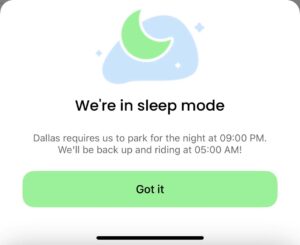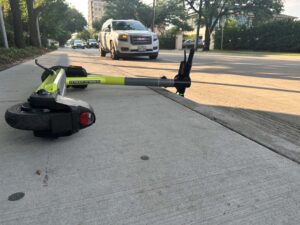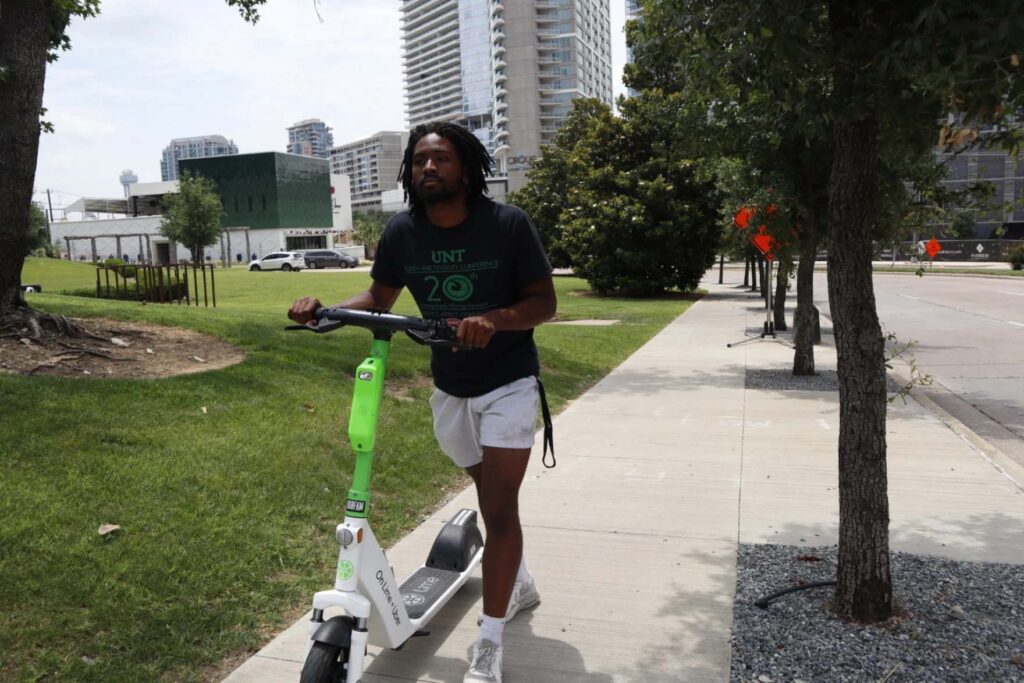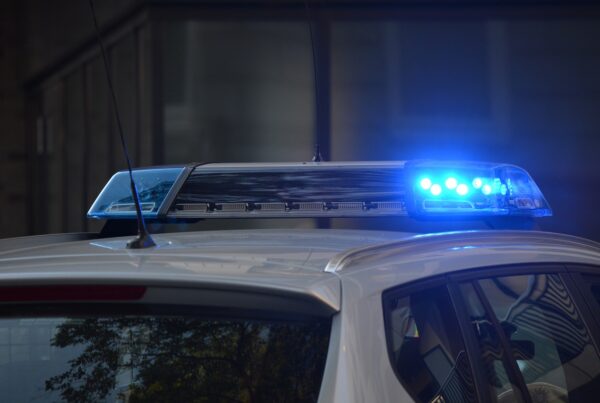From KERA News:
Love them or hate them, electric scooters are back on the streets of Dallas.
After introducing e-scooters in 2018, the Dallas Department of Transportation hit the brakes on its electric scooter rental program in 2020, citing safety concerns.
City leaders and scooter vendors say they’ve taken the last three years to receive feedback and revamp the program.
But will renewed efforts to bring shared “micro-mobility” to Dallas effectively address the issues that prompted the scooters’ removal in the first place?
New rules and restrictions
The city officially relaunched the scooter program at Dallas City Hall May 31, but scooters had been available to ride the week prior in an unofficial soft launch.
The city said Dallas’ lack of control over the scooters was one of the primary reasonsthey were taken off the streets.

Dallas Mayor Pro Tem Omar Narvaez speaks to reporters at the official relaunch of the city’s shared dockless vehicle program Wednesday, May 31, 2023.
Bekah Morr / KERA
“It was pretty scary,” said Mayor Pro Tem Omar Narvaez. “We had scooters all over the place. They looked like litter, and they were in trees. They were cut in half. They were thrown in rivers. And that was a problem.”
About 30,000 scooters were spread throughout Dallas in the initial phase of the program, Narvaez said. Significantly fewer scooters are available than before, which he said would help the city better monitor their use.
Back in December, the city evaluated how well several different brands of e-scooter slowed or stopped themselves while approaching geofenced “no-ride” or “slow-ride” zones like sidewalks, trails, parks or roads with a speed limit above 35 miles per hour.
Three different vendors made the cut — Lime, Superpedestrian and Bird. During the soft launch, each was allowed to place up to 500 of their scooters in the “Central Zone”: Downtown, Uptown and Deep Ellum.
City rules state riders must park scooters in parking corrals, bike racks or on sidewalks without blocking the walking path; improperly parking a scooter carries a $20 fine.

A “sleep mode” message that appears in the Lime mobile app after 9 p.m.
Screenshot via Lime
Scooters also can’t be operated after 9 p.m., a new rule to prevent intoxicated riding. At least one app, Superpedestrian, requires a first-time rider to take a picture of their personal I.D. to prove they’re 16 or older.
Jacob Tugendrajch, communications lead at Lime, said sharing these technical improvements with city officials and residents will hopefully build trust in what he says is still a new industry.
“We also find that as people ride e-scooters, they become advocates themselves,” Tugendrajch said. “And so, over time, we absolutely take pride in helping cities become more walkable and much easier to get around.”
Fun alternative or public nuisance?
Rental e-scooters have been touted as a viable transportation alternative because of their accessibility and cheaper costs compared to cars or other forms of public transit.
Austin Marshburn, senior director of government partnerships with Bird, said the target users for e-scooters and bikes are residents in growing downtown populations like Dallas. He said they’re an alternative for first- or last-mile transportation — getting from a final bus stop to one’s place of work, for example.
Plus, they can be pretty fun, Marshburn said.
“It’s no fun sitting in either an Uber or your own car, just sitting in traffic,” he said. “But when you get out of traffic and you get the opportunity to be outside, people end up getting where they’re going with a smile, and that actually increases its value for them.”

E-scooters are back in Dallas — and once again blocking sidewalks. This scooter was left on a sidewalk near the intersection of Maple Avenue and McKinney Avenue.
Ed Timms / KERA News
But because of the history of sidewalk clutter and some irresponsible riders, e-scooters are an annoyance for people like Klyde Warren Park security officer Janie Snell.
Snell has worked at the park, which is now a no-ride zone, for four years. She remembers the time before scooters were taken off the streets — she said riders weren’t following the rules and rode through the park, forcing her and her colleagues to reprimand them before they injured themselves or others.
“So far it’s been OK,” Snell said. “We haven’t had no issues with them or nothing like that. But to have them back? No, that’s a bad idea.”
Breaking the city’s scooter rules could earn a rider a fine of up to $200, according to city code. In addition to the fine, riders could be continually charged every minute they leave their scooter parked incorrectly.
Marshburn said for Bird scooters, that’s enforced by requiring a rider to take a picture of their parked scooter. Repeat offenses could get a user banned from the service.
Whether these consequences are enough to deter misbehavior on scooters is uncertain. During the program’s soft launch, KERA News observed multiple improperly parked scooters around the city — including one scooter strewn on the grass median in Dealey Plaza.
Narvaez said the city and vendors are aware the scooter technology isn’t perfect, but they’ll continue to make improvements.
“We’re excited about the potential for the program, and at the same time, we’re committed to ensuring that the operators are responsible and engaged in addressing challenges and issues,” he said.
Navigating the city without a car
University of North Texas student Kevin Berry lives in Denton, but said he regularly visits downtown Dallas to eat or just walk around.
When he heard scooters were coming back to the city, he figured he’d take one for a ride.
“It’s pretty cool riding around there,” he said. “I’m not gonna lie. I like riding around there.”

Kevin Berry, a University of North Texas student, took a ride on a Lime scooter during an afternoon visit to downtown Dallas May 25. Berry later had to push the scooter up a sidewalk.
Toluwani Osibamowo / KERA
Despite the fun, Berry said it sometimes felt scary riding a scooter on the main road alongside cars, especially without a bike lane. He said he wishes Dallas had more bike lanes to accommodate riders like him.
Dallas scored low with a 17 out of 100 rating in People for Bikes 2022 City Ratings; the quality of a city’s bicycle network makes up 80% of that score.
The city has vowed to create a master plan to redesign Dallas’ biking infrastructure. For now, it’s still just that — a plan.
Jamie Perkins, director of communications with Superpedestrian, said her company’s priority is protecting beginner riders by teaching them how to share the roads with drivers.
“When you’re trying something new, when you’re traveling in a new way, you don’t necessarily want to be on the street with cars,” Perkins said. “But, there are things that we can tell people to help them make those first three rides feel safer for them, and also so that they just know the rules a little bit better.”
Safety risks
When the city’s e-scooter rental program first started in 2018, Dr. Alan Jones with Baylor University Medical Center in Dallas said he and his orthopedic surgery department were treating scooter-related injuries nearly every day.
“Common scenarios were, ‘I’ve never ridden one before,’ ‘I was surprised how fast it went and I wasn’t able to control it,’” Jones said. “Many of them said that they came upon a obstacle, barrier or some sort of terrain that they were not expecting or didn’t see.”
From July 2018 to January 2019, Jones said his hospital treated 88 scooter-related injuries. Data from clinicians shows 57% of the injuries occurred after 7 p.m., 43% involved facial or head lacerations, eight required intensive care unit treatment and one resulted in death. Patients ranged in age from 13-60, Jones said.
When Jones heard e-scooters were returning, he said he and his colleagues were concerned. For him, the responsibility to keep scooter riders safe lies with riders themselves, but also scooter vendors and the City of Dallas.
Dallas city code only prohibits children under 17 from not wearing helmets on electric scooters or bikes. Jones said he worries the city’s promises of revised rules and regulations might not prevent serious and potentially life-threatening injuries.
No matter the circumstance, he said, it’s best to either wear protective gear before getting on an e-scooter or not use one at all.
“It’s not that they’re not fun. They’re fun,” Jones said. “But lots of things are fun that we don’t do because of the risk involved.”
The fate of e-scooters in Dallas is likely a matter of their summertime popularity and the lasting effects of the city’s dockless vehicle program overhaul.
District 2 Councilmember Jesse Moreno said he’s confident in the program’s success this time around.
“As a city council member that represents parts of the [Central Business District], I want to ensure that people have a way to get around our city as they explore, commute or go out for recreation,” Moreno said. “However, this is to be done in a manner that keeps everyone safe.”














